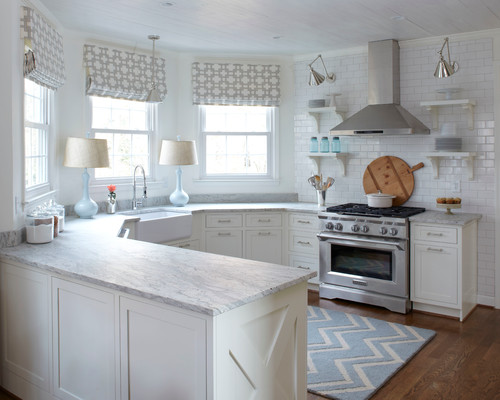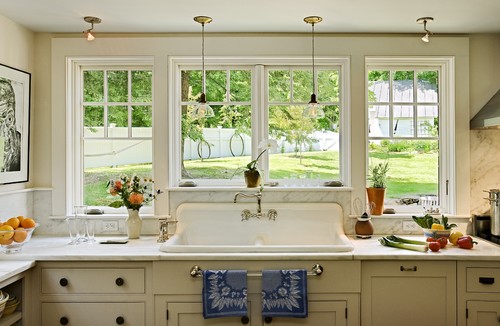Filed under: Design, Home Improvement, How To
By Becky DietrichA recent featured ideabook on white kitchens garnered a ton of comments from readers, most of which contained concerns about how to keep those beautiful kitchens clean. One Houzzer bemoaned such hard-to-maintain materials, saying that "real cooks" would question someone's sanity for using such fussy finishes.
The truth is, you don't need to be nuts to own an all-white kitchen. Just a little diligent, and armed with the tips below.

Why do those sparkling white cabinets start to yellow? The first culprit is exposure to direct sunlight, which tends to jaundice or fade painted wood (and laminated surfaces). You should consider draperies, blinds or window film to shield your cabinets from direct sunlight. (I'll be addressing protection from sun damage further in an upcoming ideabook, so stay tuned.)
The second culprit is actually using your cooktop. As soon as you start cooking, those mouthwatering aromas rise into the air in the form of microscopic food or grease particles, and since they have to land somewhere, why not on your white cabinets? The result? Cabinets that turn yellow.
To prevent this, you can't let grease accumulate on your cabinets. As soon as you begin boiling, broiling or deep-frying, turn on the exhaust fan or range hood to filter out at least some of those minuscule bits before they reach the surrounding surfaces.
Writer Lorna Hordos suggests removing a yellow tinge this way: Wash your cupboards with a fizzy mixture of 1 cup vinegar, 2 cups warm water and 1 tablespoon baking soda. To keep cabinets white, give them a monthly "bath" with a solution of warm water and a grease-busting dish soap.

If more thorough cleansing is required, use a solution of mild dishwashing liquid mixed with warm water. After cleaning, wipe all surfaces with a clean, damp cloth. Dry immediately using another soft, clean cloth.
Remember not to let those stains linger. Prolonged exposure to spills can cause permanent discoloration or damage to your cabinets' finish.
I would die for this sink. Until it started to look like I actually used it, that is. The white sinks in my home take approximately five minutes to look yucky. You can brighten them and remove stains with common household bleach. Experts suggest laying paper towels flat across the bottom of the sink and wetting them with bleach. This prevents the bleach from running straight down the drain. Leave the paper towels in place for half an hour to allow the bleach to do its job, then remove them and rinse the sink thoroughly with warm water.
For a more natural solution, fill the sink with club soda and lemon juice and let this mixture lift the stains as it soaks in. After you empty the sink, apply straight lemon juice directly to any stubborn stains. You may have to repeat this process several times.
If this sounds like way too much work, adopt my husband's favorite tool: Bar Keepers Friend. If you use it on your sink every day, no other upkeep will be required. (I use it on way more than my sink; it keeps pots and pans looking like new as well.)

Honestly, I consider sealing the grout an absolute no-brainer. Don't even contemplate living with unsealed grout.
Plastic laminate has gone from being the poor stepchild of kitchen design to a great and economical choice. (You can even dress it up with a bullnose edge, as with the example shown here, from Formica.) But it can still stain, especially if it is white. Hordos suggests this process to clean laminate stains:
1. Mix a mild household detergent with baking soda to create a firm paste. You should be able to achieve the right consistency with approximately 1 part detergent per 3 parts baking soda.
2. Apply the baking soda solution directly to the stain and scrub with a firm-bristled nylon brush. Stop after about 20 strong brushstrokes, because excess brushing may weaken the laminate finish (not to mention what all that brisk labor will do to your shoulders).
3. If you are still able to move, rinse the countertop with a damp cloth. Laminate is particularly sensitive to excess moisture, so make sure not to soak the cloth. Use just enough water to wipe away the baking soda and stain residue, and then buff the counter dry.

Or use my favorite granite cleaner from Weiman, which is way less work. When we had granite countertops, my last job at night before collapsing into my recliner was always to spray them until they shone.
OK, people, here is the dirty little secret about kitchens, whether white or dark: They all have the same issues when it comes to cleanliness! White kitchens are simply less forgiving. I am reminded of the times when decorating clients would ask me to make sure all their upholstery was covered in a dark fabric, "so it wouldn't show the dirt."
This always puzzled me and made me grimace. I imagined eons of dirt and dust being ground into the fabric, until it was as stiff as cardboard.
So if you love the look of a white kitchen, but are avoiding it because it will be a cleaning nightmare, look at it this way: Any kitchen is a cleaning nightmare. So prepare to roll up your sleeves, and pick the kitchen you really want.
More: 3 Steps to Choosing Kitchen Finishes
